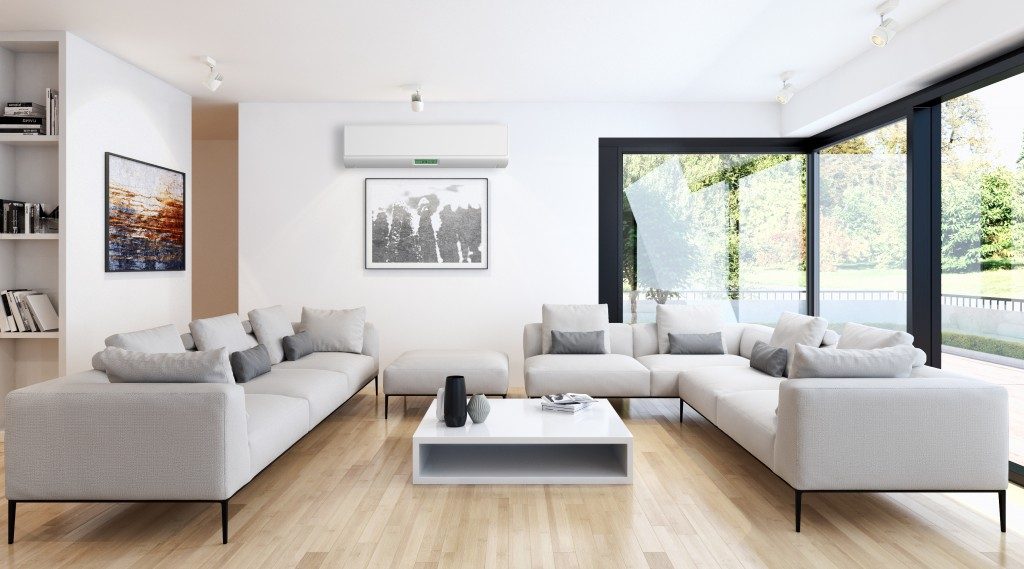People talk about the importance of the kitchen being the social center of the house, but the living room could be labeled as the “heart” of the house. Not in the sense that it is the most critical part of the house since that could be entirely subjective, but the heart in the sense that the living room’s design acts as a lynchpin for the overall aesthetic of the other rooms.
After all, it is where the family members spend their time together and is usually the place where the guests are entertained. So it is almost a requirement for all living rooms to look decent, neat, and great, but also comfortable and functional as well.
When it comes to décor, simple living rooms reign supreme. Yes, there is a way to fit in as much of your memorabilia as possible, but for small spaces, keeping it minimalist not only makes your living room more chic, it also helps you de-clutter both visually and mentally.
People often struggle with living room décor ideas, especially people living in smaller spaces (like in condos or bungalows), but here’s the good news: simple living room ideas for small spaces abound, not to mention easy to pull off and doesn’t require a lot of expensive furniture. In fact, if you do it right, you might actually earn a bit of extra from the stuff you can sell when you redecorate!
Here are a few simple living room decorating ideas for your smaller spaces. Remember: it’s not the size of the living room, it’s how you spruce it up!
Let There Be Light, And Let There Be Lots of It

Light plays a very huge role in manipulating perception: given the right angle, light can make a room spacious and homey, or dark and cozy. For smaller spaces, however, more light means more of the room is highlighted, giving it an airy and spacious feel.
Choose spot lights that accentuate dark corners, and try to use lights that are soft but bright. Remember: you’re trying to give the illusion of space, so having neutral, soft, natural-looking lights will work to your advantage.
As much as possible, try to keep your living room lit up by natural light, which means foregoing heavy curtains for some breezy and breathable fabrics. Remember: in a small space, let the light in, and let lots of it in.
Floor Spaces Actually Matter: Try Carpets
Most people are too caught up with buying the furniture, decorations, and different ornaments to place and hang around their living rooms that they sometimes take for granted one particular and important part of space: the floor.
Yes, you might be wondering what’s the point of paying attention to the details of the floor if no one ever notices it anyway? Well, that may just be precisely the point. If no one pays attention to the floor, you make your own way to make them notice it!
Try to put carpets, since there are a variety of choices anyway – there are designs that are traditional and conservative and those that are completely modern if that is the look you are going for and that is your taste. However, the floor is extremely dirty, so putting a carpet may actually need extra work in keeping them clean. In general, simple living rooms can benefit from either a rich, complex pattern (if the rest of the room is neutral) or simple monochrome (if the rest of the room has varying colors).
Go Big in a Small Space
Yes, a small living room may necessitate a simple living room design, but this doesn’t mean that you can’t have shelves for your memorabilia or accent pieces that hold special meaning for you. The thing about minimalism is that it encourages having only items that you need or hold a special connection with, not just getting rid of everything.
If you’re wondering how to organize a small house while still showcasing your personal style, the trick is to keep your belongings from becoming cluttered by placing them in strategic locations. In small homes, where storage can be a challenge, learning how to organize a small house with no storage is crucial. You can use creative solutions like floating shelves or multipurpose furniture that doubles as storage.
Don’t be afraid to have an accent piece that’s over the top, especially if you’ve already designed the rest of your room to be minimal: this acts as a dramatic visual shift that creates intrigue and awe, while also maximizing the use of your limited space.
Speaking of Shelves: Streamline Them

Try to refresh your storage or mini-library by lining them up on the shelves to expose the covers and make the monochromatic vibe of the papers stand out through coordinating them. Shelves are not that much of a usual appearance on living rooms, but if you are going for limited spaces putting a shelf does not make your room look too crowded.
In fact, it would draw eyes on the shelf itself and not on how much space it took. Load up your book collection or jackets in yard sales to make this streamlined shelf a reality!
Closer is Cozier
It almost sounds contradictory, but actually decreasing the space you use up in a small living room will actually make it look and feel more spacious. By leveraging the space that you have to be more utilitarian, it creates a visual effect that expands the rest of the room and creates negative space that the eyes translate as usable space.
Lean into your simple living room’s size and don’t treat it as a downside!
A small living room means you get to position seats closer to each other, creating a cozier room that your family and guests will love to be in.
Keep It Green with Plants in Your Living Room

As mentioned earlier, space matters a little when it is maximized at its fullest potential. So if you have underused corners or nooks around your living room, try filling it with an indoor house plant. You have to pick the plants wisely and make sure those are the types of plants that could survive in harsh conditions with very little sunlight.
Once you have placed your house plant in the corner of your living room, it would instantly become the focal point and attention-grabber of the whole room!
The Color of Space
Just like light, color plays a huge role in manipulating perception: darker colors can create a sophisticated and elegant backdrop, while lighter colors create a sense of home and coziness. The best way to go about this is to paint your walls and your ceilings the same color: this creates a seamless effect that your eyes will translate as more space.
Make sure that your wall colors either complement or contrast: bright furniture will pop in darker backgrounds, while neutral furniture work well with brighter colors. Whichever way you go, try to keep your colors consistent and simple: patterns are fun but, if you have limited space, it might be better to go with something monochrome, if only to create the illusion of room.
When decorating your living room, you could always experiment with things that are not usual with streamlined shelves, then maximizing all types of spaces from the floor and all the way to nooks and corners around it! The living room should look presentable and comfortable enough.






